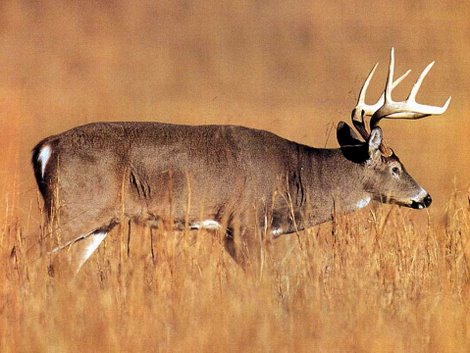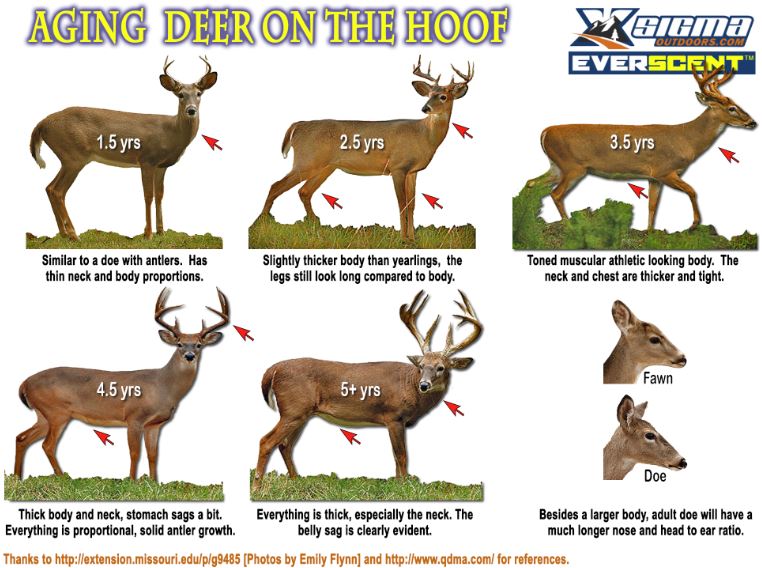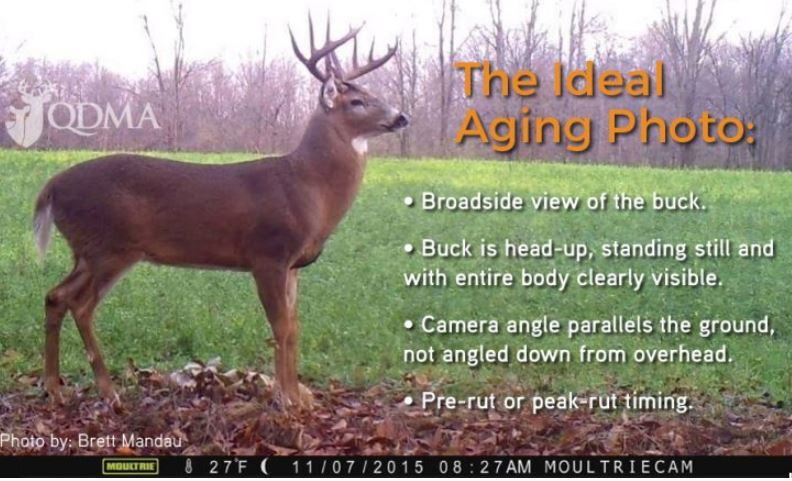Learning to estimate the age of a white-tailed deer on the hoof is an invaluable skill for any serious deer hunter or manager, especially as it pertains to buck harvest. Whether you want to estimate the age structure of the whitetail population found on a property or want to make specific determinations regarding the harvest of particular bucks, it takes time to get good at aging live deer. This article is designed to start you on the path to accurately aging deer on the hoof.

Most hunters do not have access to free-ranging deer of known ages, so this makes the learning process more difficult, but not impossible. Just about everyone is using motion-triggered cameras nowadays and these game camera photos provide excellent opportunities to practice. Whether you use your trail cameras to conduct surveys to estimate your deer population or just to gather snapshots of bucks using the area, accurately estimating ages is paramount to assessing the progress of a management program.
Aging of Bucks is Important
Harvesting bucks at the optimal age is an important aspect of white-tailed deer management. Research and experience has revealed to biologists that whitetail bucks reach maximum antler growth between 5 and 7 years of age. There may be some hunters that insist on allowing bucks to get even older (and sometimes bigger), but annual mortality is always an issue with bucks, especially once their mature.
From my experience, free-ranging bucks that are 5 years old are old enough and will not increase substantially in antler size. Furthermore, research has found that a 4 year old (whitetail) buck’s antlers represent 90 percent of the buck’s potential for total antler growth. You will have some really good bucks even if the goal for the property/deer you manage is to get them to 4 1/2 years of age.

Besides, if you’re managing for 4 year old bucks then you will undoubtedly have some 5+ year old bucks on on your hunting grounds. Once a buck grows older he gets a bit smarter too, so he may become a live target at 4 years old but drop off the radar come hunting season, only to re-emerge a year or two later, if you’re lucky.
Regardless of whether the goal is to harvest bucks that are at least 4, 5 or 6 years of age, it still takes hunters that are proficient at aging deer on the hoof to get there. Dead bucks don’t get any older.
Deer Management Means Learning to Age Whitetail
Whether you plan on harvesting bucks at 3 1/2 or 6 1/2 years of age you need to be able to estimate the age of deer on the hoof. The ability to rank a buck’s antler quality (compared to his peers) depends on property aging, too. There are three factors that influence antler size and development in whitetail bucks: age, genetics and nutrition.
The age of a buck is important for developing quality antlers and must be considered in combination with nutrition with some amount of genetic input. In fact, I find many properties are focusing way too much on genetics when efforts would better used enhancing deer habitat and simply allowing bucks to get older before they are shot.
The majority of hunters would be tickled pink to shoot a mature buck on quality habitat. It takes active management to provide good cover and food, as well as having a trigger finger that exhibits patience.
Improve Deer Aging Skills Through Backtesting
It’s not easy to age free-ranging deer when you’re starting out, but you can greatly improve “target recognition” through backtesting. This involves using game camera photos of bucks that you or others have harvested previously, off of your hunting grounds. Deer body sizes vary from place to place, so you want to learn using the deer that you will be hunting. It would not help much your management program if you could accurately age deer in Central Texas but were managing deer in Ohio. They look completely different.
Key points for aging deer on the hoof include:
- Shape of head – a mature buck’s appears short, deep
- Body size – younger bucks are thin, doe-like
- Neck – fills out deeper into shoulders as bucks age
- Depth of body – deeper body on older bucks
- Leg length – older bucks appear short-legged
Start a backtesting program on your hunting lands by maintaining game cameras prior to the hunting seasons. As bucks are harvested, age the bucks based on tooth wear and replacement. Over a few years you will start to get a good handle on what bucks of different ages look like. This is especially helpful when particular bucks can be tracked over several years.

Say a deer is shot at 5 1/2 years of age, well then if the buck is readily identifiable you can go back to your photo vault and see that same deer in prior years, say at 3 and 4 years of age and see how his physical and antler characteristics have changed.
Of course, I must mention that aging deer based on tooth wear is not an exact science either, as wear also varies from area to area based on soils. The teeth of deer that live in sandy soils wear down faster than the teeth of deer living on clay soils. The overall idea is to use tooth wear from harvested bucks and physical characteristics of those deer in photos to build the best photo library of “known-age” deer on your hunting grounds.
Aging Deer in the Field: It’s Not Perfect!
Aging deer on the hoof is an inexact science, but it’s all that we’ve got. Aging deer accurately beyond 2 1/2 years of age based on tooth wear (with the jawbone in hand) can be tricky enough for those just starting out, but estimating the ages of live deer in the field can be downright difficult.
My advice is to be patient and get photos of the bucks in your area prior to the hunting season. Start by sorting bucks captured on camera into groups such as young (1-2), middle-aged (3-4) and mature (5+ years old) and then see how those estimates play out come hunting season, once those deer are tagged.
As you will see, aging deer is not always clear-cut. Whether you are exactly right is not as important for your deer management program as whether or not you, or the other hunters where you hunt, can differentiate between older deer and high quality younger bucks with a lot of potential. Mistakes will always be made, so don’t waste them, learn from them.
3 1/2 year old?
5 and 1/2 years old??
4 1/2 year old
Of all the things to look at on a buck to age him in the field, what is the single most important thing?
Marian, the most important thing is body conformation. A buck that has a deep chest and appears short-legged is going to be a mature buck. A buck with a thin body that looks long-legged is going to be young. Good question!
the deer in the pic looks to be 3.5, his neck comes in to his body slightly above the bottom of his chest. his head is still slightly elongated
Thank you for this content. I’m a wildlife ecology education volunteer and student. May I use your charts for an educational presentation at my local forest preserve (Six Mile Cypress Slough) to demonstrate age differentiation? Not for profit of course and with credit given?
Amanda, I’m glad that you found these charts for aging deer helpful! They are great educational tools and important for those interested in practicing selective buck harvest.